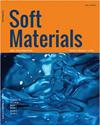Biomolecules of Similar Charge Polarity Form Hybrid Gel
IF 1.6
4区 材料科学
Q4 MATERIALS SCIENCE, MULTIDISCIPLINARY
引用次数: 0
Abstract
ABSTRACT We report intermolecular gelation of deoxyribonucleic acid (DNA) and folic acid (FA, 1% (w/v) and DNA, 0.1–0.5% (w/v)) in Dimethyl Sulfoxide (DMSO)-water solution despite both having similar net charge. Zeta potential ζ of the biopolymers was, ζDNA = −58 and ζFA = −18 mV, therefore, formation of a self-organized hybrid network structure to assign sufficient rigidity to the gel must happen in the environment of electrostatic repulsion persisting between the inter and intra polymer segments. Regardless, a stable supramolecular hydrogel was formed at room temperature of 25° C with the DNA–FA complex displaying a zeta potential of ζcomplex = −21 mV. The gel strength (low frequency storage modulus, G 0) was tunable from ≈ 500 to 50 Pa, and gelation temperature T gel from 70 to 60° C, decreasing with DNA content. These soft gels were systematically characterized over several decades of time (dynamic light scattering), and length scales (small angle neutron scattering), rheology and scanning electron microscopy to obtain a deeper understanding of the self-assembly of the DNA in the FA-dominant solution. These gels formed of same polarity biopolymers, and in a milieu of strong electrostatic repulsion, make these belong to a special class of soft matter not well studied in the past.具有相似电荷极性的生物分子形成杂化凝胶
我们报道了脱氧核糖核酸(DNA)和叶酸(FA, 1% (w/v)和DNA, 0.1-0.5% (w/v))在二甲基亚砜(DMSO)水溶液中的分子间凝胶化,尽管两者具有相似的净电荷。生物聚合物的ζ电位ζ为,ζ dna =−58,ζ fa =−18 mV,因此,自组织杂化网络结构的形成必须发生在聚合物段间和段内持续存在静电排斥的环境中,以赋予凝胶足够的刚性。无论如何,在室温25℃下形成了稳定的超分子水凝胶,DNA-FA络合物的ζ电位为ζ络合物=−21 mV。凝胶强度(低频存储模量g0)可调范围为≈500 ~ 50 Pa,凝胶温度T可调范围为70 ~ 60℃,凝胶强度随DNA含量的增加而降低。这些软凝胶在几十年的时间(动态光散射)、长度尺度(小角中子散射)、流变学和扫描电镜下进行了系统的表征,以更深入地了解DNA在fa优势溶液中的自组装。这些凝胶是由相同极性的生物聚合物形成的,并且在强静电排斥的环境中,使它们属于一类特殊的软物质,过去没有得到很好的研究。
本文章由计算机程序翻译,如有差异,请以英文原文为准。
求助全文
约1分钟内获得全文
求助全文
来源期刊

Soft Materials
工程技术-材料科学:综合
CiteScore
2.90
自引率
0.00%
发文量
21
审稿时长
2.2 months
期刊介绍:
Providing a common forum for all soft matter scientists, Soft Materials covers theory, simulation, and experimental research in this rapidly expanding and interdisciplinary field. As soft materials are often at the heart of modern technologies, soft matter science has implications and applications in many areas ranging from biology to engineering.
Unlike many journals which focus primarily on individual classes of materials or particular applications, Soft Materials draw on all physical, chemical, materials science, and biological aspects of soft matter. Featured topics include polymers, biomacromolecules, colloids, membranes, Langmuir-Blodgett films, liquid crystals, granular matter, soft interfaces, complex fluids, surfactants, gels, nanomaterials, self-organization, supramolecular science, molecular recognition, soft glasses, amphiphiles, foams, and active matter.
Truly international in scope, Soft Materials contains original research, invited reviews, in-depth technical tutorials, and book reviews.
 求助内容:
求助内容: 应助结果提醒方式:
应助结果提醒方式:


